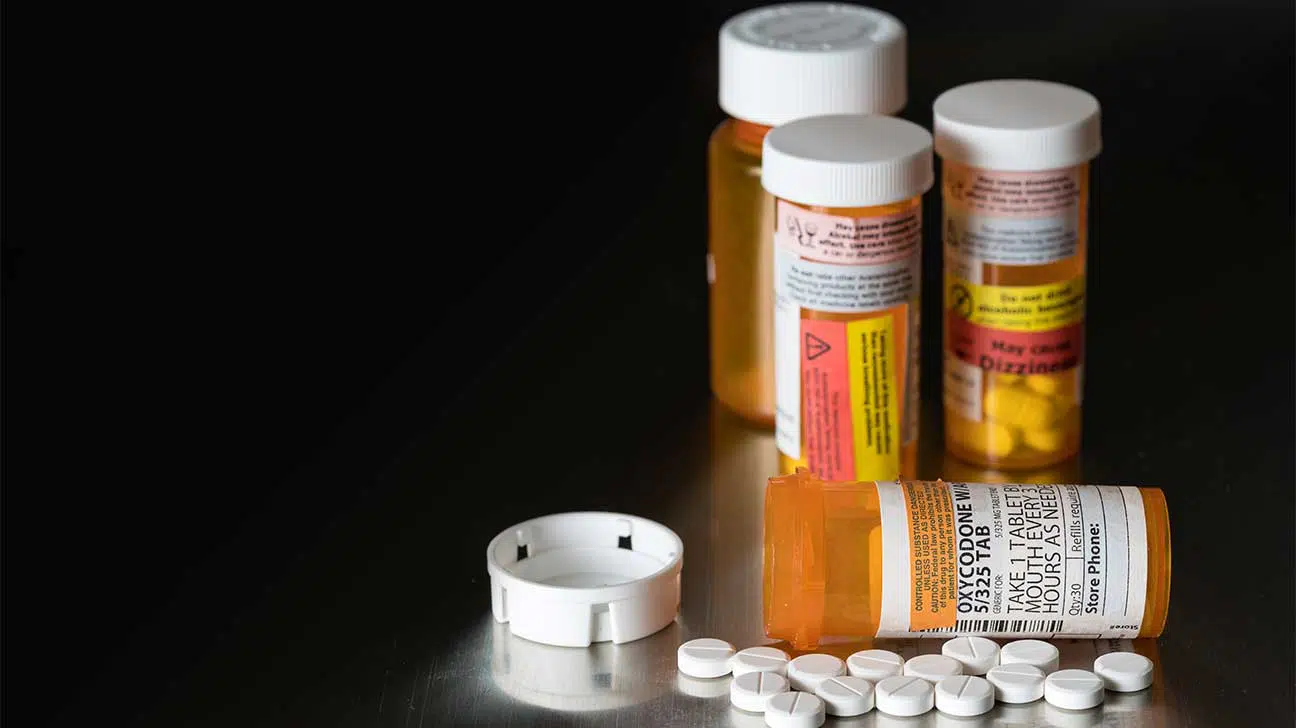
Chronic use of opioid drugs like oxycodone and heroin can build what’s known as opioid tolerance.
Opioid tolerance occurs when your body becomes intolerant or accustomed to, a certain dosage of an opioid, which can weaken or null the drug’s effects.
The development of opioid tolerance can cause some people to increase their opioid use. Without clinical guidance, this can increase the risk for opioid abuse and addiction.
Here you’ll find information on:
- types of opioid tolerance
- causes of opioid tolerance
- signs of opioid tolerance
- risks of opioid tolerance
- finding treatment options for opioid abuse
What Are Common Types Of Opioid Tolerance?
You can become tolerant to the effects of all opioid agonists, because they affect the central nervous system (CNS), consisting of the brain and spinal cord.
Common types of opioid tolerance include:
- oxycodone tolerance
- heroin tolerance
- fentanyl tolerance
- tramadol tolerance
- morphine tolerance
- hydrocodone tolerance
- Suboxone tolerance
- methadone tolerance
Opioid Tolerance Vs. Dependence Vs. Drug Addiction
Tolerance is sometimes confused with physical dependence on a drug, as well as a drug addiction. But there are important differences between the three.
Opioid Tolerance
According to the U.S. National Institutes on Drug Abuse, tolerance is what happens when the body no longer responds to a drug the same way.
This typically develops with chronic use—or, regular use for at least several weeks—as the body becomes accustomed to the drug and the side effects of opioids.
If you’re taking a prescription opioid and build tolerance, a doctor may direct you to increase your dosage, with instructions on how to do so safely.
Opioid Dependence
Drug dependence is different from tolerance. Unlike tolerance, opioid dependence can cause the body to go through drug withdrawal if the use of a drug is reduced or stopped very suddenly.
Like tolerance, dependence takes time to develop. It can also become more severe and potentially dangerous if it develops as a result of opioid abuse.
Opioid Addiction
Opioid addiction, also known as opioid use disorder, is a disease that’s characterized by compulsive drug use.
This can have a physical component (dependence) as well as a psychological component that can make it hard to quit the drug.
What Causes Opioid Tolerance?
A tolerance to opioids can develop through several different mechanisms and may be influenced in part by certain behaviors and environmental factors.
But the primary cause of opioid tolerance is long-term opioid use. For instance, taking a prescription opioid analgesic daily for several weeks or more.
Mechanisms for developing tolerance include:
- pharmacokinetic factors (i.e. metabolic tolerance)
- pharmacodynamic factors (i.e. functional tolerance)
- behavioral factors
- environmental factors
- genetics
Chronic opioid use causes repeated stimulation. This repeated exposure can then alter how the body reacts to a drug over time, requiring higher doses of the drug to experience the desired effect.
Signs Of An Opioid Tolerance
Signs that you have built up a tolerance or desensitization to opioids are fairly straightforward.
The primary signs of opioid tolerance include:
- needing larger concentrations of an opioid to feel its effects (e.g. pain relief)
- experiencing reduced analgesic effects over time when taking the same dosage
Increasing your opioid use, by taking high doses or taking doses more often, can lead to the development of a high tolerance.
People who have not taken opioids before, or take it infrequently, will have a low tolerance for opioids, which can be dangerous if exposed to a high dose.
Crossover Tolerance With Opioids
The opioid drug class contains a wide range of opioid drugs, from the natural opiate morphine, to fully synthetic opioids like methadone and fentanyl.
Because all opioids act on the same opioid receptors, the development of a tolerance to one will result in some level of tolerance for other opioids as well.
This is what’s known as crossover tolerance.
Overdose Risk
People with a low tolerance for opioids, including opioid-naive children, are at high risk for an opioid overdose when or if they are exposed to opioids.
When you have a low tolerance, your body will not respond to opioids in the same way as someone who takes opioids regularly. So, it can become more easily overwhelmed.
Dangers of overdose include:
- respiratory depression (slowed or stopped breathing)
- brain damage
- liver or kidney damage
- coma
- death
This is one factor that has contributed to the rise in opioid overdose deaths involving drugs like cocaine and meth bought through the unregulated drug market.
Treatment For Opioid Tolerance And Addiction
Having a high analgesic tolerance is not dangerous by itself. But it can be if it’s accompanied by struggles with opioid abuse or addiction.
Getting help for opioid abuse through a drug abuse treatment program is highly recommended, particularly if you have a high tolerance.
Opioid abuse can be life-threatening and may affect all areas of your life, from your relationships, to mental health, and overall quality of life.
Treatment for opioid abuse may involve:
- opioid detoxification
- medication for opioid use disorder (e.g. methadone, buprenorphine)
- behavioral therapy
- group therapy
- pain management care
- relapse prevention
- aftercare planning
Opioid Tolerance FAQs
Find answers to frequently asked questions about tolerance to opiates.
Which Opioids Cause Tolerance?
Tolerance can build through the use of any opioid. This includes prescription opioids like oxycodone and methadone, as well as illicit fentanyl and heroin.
Can You Lose Your Opioid Tolerance?
Yes. Stopping an opioid, or weaning off a high opioid dose, can cause you to lose your tolerance for opioid drugs.
What Causes You To Lose Opioid Tolerance?
Your tolerance for opioid drugs can decrease, or be lost, if you stop your opioid therapy, or stop taking opioids for any other use for a period of time.
This commonly occurs with detox, reducing illicit opiate use (e.g. heroin use), or weaning off a prescription opioid medication.
Getting Help For Opioid Abuse And Addiction
Opioid tolerance is a risk factor for opioid abuse and addiction. If you or a loved one has become addicted to opioids, we may be able to help.
Call our helpline today for more information about opioid abuse and how to find an opioid treatment program that’s right for you.
Addiction Resource aims to provide only the most current, accurate information in regards to addiction and addiction treatment, which means we only reference the most credible sources available.
These include peer-reviewed journals, government entities and academic institutions, and leaders in addiction healthcare and advocacy. Learn more about how we safeguard our content by viewing our editorial policy.
- Anesthesiology
https://pubs.asahq.org/anesthesiology/article/124/2/483/12697/Differential-Opioid-Tolerance-and-Opioid-induced - British Journal of Anesthesia
https://watermark.silverchair.com/810058.pdf?token=AQECAHi208BE49Ooan9kkhW_Ercy7Dm3ZL_9Cf3qfKAc485ysgAAAr0wggK5BgkqhkiG9w0BBwagggKqMIICpgIBADCCAp8GCSqGSIb3DQEHATAeBglghkgBZQMEAS4wEQQMNxsCarJ0C89Au6-rAgEQgIICcK18ue1suFsUfHqR_pUx-5qpv3QNB6Xsx3KPFA6jk4P1dw3Irp_XiXD8Ql_pVL9QaSjrflerHSZI56hNIWNLyMsSNtRM7hV13T4dhOhoxXpmZHOCm0NN9tOE8vvNKkpsTIqHVuIVv_FfW5jUo3dIzSk-L9UNodMkpYxKKUOXa0QbY6dhh9YDYj_tXOU-EeNHBmB2WR2BYOqCzmANHy0_fVya_V3WiRAAFfa9uvlBCCvg8Ir_RV8ITr-Cigpv4kk25B9R-BEdj-QF9W7eLRzqOTzaS06WeCasDv0XRSdx8jjzcSz76qNGQ1Vp_VRJQA_JP1B2L9c6wD0MOJdO5hNMgME6XVFKzCpeGOrvzmVle2C2orZ98hwx1vPoPn62myyCtUxNQ7ll9Xu_LSN5Kis5MTEsTtxukS5OX_KcxfLUXsXHdD6UCOvXZvmhW8WLkhp3uP3xrsndpl4Vh4ZB_Rc9b5ek4Wcz72cHm7bOXlwpnEwiW9Dl6j6SYZqIHaCAP5x_AsIRT1fMsziy-_chJtxOF56rTS3fh74g8V1WzXkWtANTIgJits6qbOsj4XzQV37iCnM2b5eEdx_vCOywEaPv6b32KV8SuGqktxqmwFvpTCGqmTS86qpxWtvEAuC_JYhAU9zKmk_zzr2LxhdLSZLz69R6c1cWKu1S5fq2ZWoTNB3Vx9zC3ZMIBoFk5_c7nTA3Fh1pZUXvGzDjetwlx9BAe74o7nBiwYnX9G86HdLSYfdCxEfG_OZiIWCjegBQdXWX7FPZXnP9_xwD4Yp26LLwWiM-v6rr3FCi-1-wsJ_dO97cg4VjQTBbUrf2OCo3wuBkIA - Journal of Clin. Anesthesthesia
https://pubmed.ncbi.nlm.nih.gov/27185670/ - U.S. National Institute on Drug Abuse (NIDA)
https://archives.drugabuse.gov/blog/post/tolerance-dependence-addiction-whats-difference - U.S. National Library of Medicine: Medline Genetics
https://medlineplus.gov/genetics/condition/opioid-addiction/ - Frontiers in Pharmacology-— Opioid receptor desensitization: mechanisms and its link to tolerance
https://doi.org/10.3389/fphar.2014.00280


